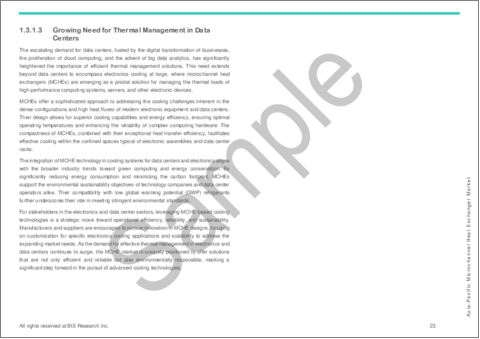|
|
市場調査レポート
商品コード
1622831
アジア太平洋のマイクロチャネル熱交換器市場:用途別、製品別、国別 - 分析と予測(2024年~2033年)Asia-Pacific Microchannel Heat Exchanger Market: Focus on Application, Product, and Country - Analysis and Forecast, 2024-2033 |
||||||
カスタマイズ可能
|
|||||||
| アジア太平洋のマイクロチャネル熱交換器市場:用途別、製品別、国別 - 分析と予測(2024年~2033年) |
|
出版日: 2024年12月27日
発行: BIS Research
ページ情報: 英文 67 Pages
納期: 1~5営業日
|
- 全表示
- 概要
- 図表
- 目次
アジア太平洋のマイクロチャネル熱交換器の市場規模は、2024年の63億300万米ドルから2033年には155億610万米ドルに達し、予測期間の2024年~2033年のCAGRは10.52%になると予測されています。
アジア太平洋のマイクロチャネル熱交換器市場は、再生可能エネルギー、自動車、暖房・換気・空調(HVAC)などの分野でエネルギー効率の高い熱管理ソリューションへのニーズが高まっていることから、急速に拡大しています。マイクロチャネル熱交換器は、特に電気自動車への移行が進み、効率的な熱管理が重要になるにつれて、小型で高効率であることから大きな需要があります。
また、環境意識の高まりや、材料回収や循環型経済などの持続可能な慣行への注目も、採用に拍車をかけています。同地域が二酸化炭素排出量の削減に重点を置いていることに伴い、産業界は環境に優しいソリューションをますます重視するようになっています。さらに、多額の研究開発費がマイクロチャネル熱交換器の技術開発を後押ししています。
| 主要市場統計 | |
|---|---|
| 予測期間 | 2024年~2033年 |
| 2024年の評価 | 63億300万米ドル |
| 2033年の予測 | 155億610万米ドル |
| CAGR | 10.52% |
再生可能エネルギー、自動車、暖房・換気・空調(HVAC)など、多くの分野でエネルギー効率の高い熱管理ソリューションへのニーズが高まっているため、アジア太平洋のマイクロチャネル熱交換器市場は急成長しています。これらの熱交換器は、その軽量設計、優れた熱性能、コンパクトなサイズが高く評価され、現代の用途に不可欠なものとなっています。
マイクロチャネル熱交換器の採用は、この地域の電気自動車へのシフトによって加速しており、高度な熱管理システムの重要性がさらに浮き彫りになっています。マイクロチャネル熱交換器は、電気自動車の冷却システムを最適化し、エネルギー効率と性能の向上を保証する能力を備えているため、変化する自動車業界にとって不可欠です。
アジア太平洋では環境の持続可能性が重要な焦点となっており、産業界は廃棄物やカーボンフットプリントを削減するために循環経済の原則や持続可能な製造方法を導入しています。マイクロチャネル熱交換器は、リサイクル可能な部品や環境に優しい素材を使用することで、これらの目標をサポートし、市場シェアを拡大しています。
当レポートでは、アジア太平洋のマイクロチャネル熱交換器市場について調査し、市場の概要とともに、用途別、製品別、国別の動向、および市場に参入する企業のプロファイルなどを提供しています。
目次
エグゼクティブサマリー
第1章 市場
- 動向:現在および将来の影響評価
- サプライチェーンの概要
- 研究開発レビュー
- 規制状況
- ステークホルダー分析
- 主要な世界的出来事の影響分析-COVID-19、ロシア/ウクライナ、中東危機
- 主な開発と進行中のプロジェクト
- 市場力学:概要
第2章 地域
- 地域別概要
- 促進要因と抑制要因
- アジア太平洋
第3章 市場-競合ベンチマーキングと企業プロファイル
- 今後の見通し
- 地理的評価
- SANHUA HOLDING GROUP
- WELCON Inc.
- Shanghai Shenglin M&E Technology Co. Ltd.
- Zhejiang Dunan Artificial Environment Co. Ltd.
- Sumitomo Precision Products Co. Ltd.
第4章 調査手法
List of Figures
- Figure 1: Microchannel Heat Exchanger Market (by Region), $Million, 2023, 2027, and 2033
- Figure 2: Asia-Pacific Microchannel Heat Exchanger Market (by End-Use Industry), $Million, 2023, 2027, and 2033
- Figure 3: Asia-Pacific Microchannel Heat Exchanger Market (by Material Type), $Million, 2023, 2027, and 2033
- Figure 4: Asia-Pacific Microchannel Heat Exchanger Market (by Fluid Mechanism), $Million, 2023, 2027, and 2033
- Figure 5: Microchannel Heat Exchanger Market, Recent Developments
- Figure 6: Supply Chain and Risks within the Supply Chain
- Figure 7: Microchannel Heat Exchanger Market (by Capacity (kW)), Global Pricing Snapshot, $U.S./Unit, 2023-2033
- Figure 8: Patent Analysis (by Country), January 2020 and December 2023
- Figure 9: Patent Analysis (by Company), January 2020 and December 2023
- Figure 10: China Microchannel Heat Exchanger Market, $Million, 2023-2033
- Figure 11: Japan Microchannel Heat Exchanger Market, $Million, 2023-2033
- Figure 12: South Korea Microchannel Heat Exchanger Market, $Million, 2023-2033
- Figure 13: India Microchannel Heat Exchanger Market, $Million, 2023-2033
- Figure 14: Rest-of-Asia-Pacific Microchannel Heat Exchanger Market, $Million, 2023-2033
- Figure 15: Strategic Initiatives, 2021-2023
- Figure 16: Share of Strategic Initiatives, 2021-2023
- Figure 17: Data Triangulation
- Figure 18: Top-Down and Bottom-Up Approach
- Figure 19: Assumptions and Limitations
List of Tables
- Table 1: Market Snapshot
- Table 2: Microchannel Heat Exchanger Market, Opportunities across Regions
- Table 2: Impact Analysis of Market Navigating Factors, 2024-2033
- Table 1: Microchannel Heat Exchanger Market (by Region), $Million, 2023-2033
- Table 2: Asia-Pacific Microchannel Heat Exchanger Market (by End-Use Industry), $Million, 2023-2033
- Table 3: Asia-Pacific Microchannel Heat Exchanger Market (by Material Type), $Million, 2023-2033
- Table 4: Asia-Pacific Microchannel Heat Exchanger Market (by Fluid Mechanism), $Million, 2023-2033
- Table 5: China Microchannel Heat Exchanger Market (by End-Use Industry), $Million, 2023-2033
- Table 6: China Microchannel Heat Exchanger Market (by Material Type), $Million, 2023-2033
- Table 7: China Microchannel Heat Exchanger Market (by Fluid Mechanism), $Million, 2023-2033
- Table 8: Japan Microchannel Heat Exchanger Market (by End-Use Industry), $Million, 2023-2033
- Table 9: Japan Microchannel Heat Exchanger Market (by Material Type), $Million, 2023-2033
- Table 10: Japan Microchannel Heat Exchanger Market (by Fluid Mechanism), $Million, 2023-2033
- Table 11: South Korea Microchannel Heat Exchanger Market (by End-Use Industry), $Million, 2023-2033
- Table 12: South Korea Microchannel Heat Exchanger Market (by Material Type), $Million, 2023-2033
- Table 13: South Korea Microchannel Heat Exchanger Market (by Fluid Mechanism), $Million, 2023-2033
- Table 14: India Microchannel Heat Exchanger Market (by End-Use Industry), $Million, 2023-2033
- Table 15: India Microchannel Heat Exchanger Market (by Material Type), $Million, 2023-2033
- Table 16: India Microchannel Heat Exchanger Market (by Fluid Mechanism), $Million, 2023-2033
- Table 17: Rest-of-Asia-Pacific Microchannel Heat Exchanger Market (by End-Use Industry), $Million, 2023-2033
- Table 18: Rest-of-Asia-Pacific Microchannel Heat Exchanger Market (by Material Type), $Million, 2023-2033
- Table 19: Rest-of-Asia-Pacific Microchannel Heat Exchanger Market (by Fluid Mechanism), $Million, 2023-2033
- Table 20: Market Share
Introduction to Asia-Pacific Microchannel Heat Exchanger Market
The Asia-Pacific microchannel heat exchanger market is projected to reach $15,506.1 million by 2033 from $6,303.0 million in 2024, growing at a CAGR of 10.52% during the forecast period 2024-2033. The market for APAC microchannel heat exchangers is expanding quickly due to the growing need for energy-efficient thermal management solutions in sectors like renewable energy, automotive, and heating, ventilation, and air conditioning (HVAC). Microchannel heat exchangers are in great demand due to their small size and high efficiency, particularly as the area switches to electric vehicles and efficient thermal management becomes more important.
Adoption is also fueled by growing environmental consciousness and the focus on sustainable practices, such as material recovery and the circular economy. In line with the region's emphasis on lowering carbon emissions, industries are placing an increasing emphasis on environmentally friendly solutions. Furthermore, substantial R&D expenditures are boosting technological developments in microchannel heat exchangers.
| KEY MARKET STATISTICS | |
|---|---|
| Forecast Period | 2024 - 2033 |
| 2024 Evaluation | $6,303.0 Million |
| 2033 Forecast | $15,506.1 Million |
| CAGR | 10.52% |
Another important area of focus is supply chain resilience, which guarantees consistent growth and satisfies demands.
Market Introduction
The market for APAC microchannel heat exchangers is growing quickly due to the increasing need for energy-efficient thermal management solutions in a number of sectors, such as renewable energy, automotive, and heating, ventilation, and air conditioning (HVAC). These exchangers are highly valued for their lightweight design, excellent thermal performance, and compact size, which makes them indispensable in contemporary applications.
The adoption of microchannel heat exchangers has been accelerated by the region's shift to electric vehicles, which has further highlighted the significance of sophisticated thermal management systems. They are essential to the changing automotive landscape because of their capacity to optimize cooling systems in electric vehicles, guaranteeing energy efficiency and improved performance.
Environmental sustainability is a key focus in APAC, with industries implementing circular economy principles and sustainable manufacturing practices to reduce waste and carbon footprints. Microchannel heat exchangers' use of recyclable parts and environmentally friendly materials supports these goals and increases their market share.
Research and development expenditures are encouraging ongoing innovation, which leads to goods that are more robust, effective, and economical. Furthermore, initiatives to improve supply chain resilience are guaranteeing a consistent supply of goods to satisfy the expanding demand in the region.
The market for APAC microchannel heat exchangers is expected to grow steadily due to rising urbanization, industrialization, and sustainability awareness, which will help the region achieve its energy and environmental objectives.
Market Segmentation
Segmentation 1: by End-Use Industry
- Automotive
- HVAC
- Commercial Refrigeration
- Others
Segmentation 2: by Material Type
- Metal
- Ceramic
Segmentation 3: by Fluid Mechanism
- Single Coil
- Dual Coil
- Multi Coil
Segmentation 4: by Country
- China
- Japan
- South Korea
- India
- Rest-of-Asia-Pacific
How can this report add value to an organization?
Product/Innovation Strategy: This report provides a comprehensive product/innovation strategy for the apac microchannel heat exchanger market, identifying opportunities for market entry, technology adoption, and sustainable growth. It offers actionable insights, helping organizations leverage microchannel heat exchangers to meet environmental standards, gain a competitive edge, and capitalize on the increasing demand for eco-friendly solutions in various industries.
Growth/Marketing Strategy: This report offers a comprehensive growth and marketing strategy designed specifically for the microchannel heat exchanger market. It presents a targeted approach to identifying specialized market segments, establishing a competitive advantage, and implementing creative marketing initiatives aimed at optimizing market share and financial performance. By harnessing these strategic recommendations, organizations can elevate their market presence, seize emerging prospects, and efficiently propel revenue expansion.
Competitive Strategy: This report crafts a strong competitive strategy tailored to the apac microchannel heat exchanger market. It evaluates market rivals, suggests methods to stand out, and offers guidance for maintaining a competitive edge. By adhering to these strategic directives, companies can position themselves effectively in the face of market competition, ensuring sustained prosperity and profitability.
Table of Contents
Executive Summary
Scope and Definition
1 Markets
- 1.1 Trends: Current and Future Impact Assessment
- 1.1.1 Trends: Current and Future Impact Assessment
- 1.1.1.1 Rise in Demand for Microchannel Heat Exchangers (MCHEs) in the Manufacturing Industry
- 1.1.1.2 Rapid Growth of the Construction Industry Worldwide
- 1.1.1 Trends: Current and Future Impact Assessment
- 1.2 Supply Chain Overview
- 1.2.1 Value Chain Analysis
- 1.2.2 Market Map
- 1.2.2.1 Microchannel Heat Exchanger Market - by End-Use Industry
- 1.2.2.1.1 Automotive
- 1.2.2.1.2 Heating, Ventilation, and Air Conditioning (HVAC)
- 1.2.2.1.3 Commercial Refrigeration
- 1.2.2.1.4 Others
- 1.2.2.1 Microchannel Heat Exchanger Market - by End-Use Industry
- 1.2.3 Pricing Forecast
- 1.3 Research and Development Review
- 1.3.1 Patent Filing Trend (by Country and Company)
- 1.4 Regulatory Landscape
- 1.5 Stakeholder Analysis
- 1.5.1 Use Case
- 1.5.2 End User and Buying Criteria
- 1.6 Impact Analysis for Key Global Events-COVID-19, Russia/Ukraine, or Middle East Crisis
- 1.7 Major Developments and Ongoing Projects
- 1.8 Market Dynamics: Overview
- 1.8.1 Market Drivers
- 1.8.1.1 Stringent Environmental Standards and Energy Efficiency Regulations
- 1.8.1.2 High Demand from Heating, Ventilation, Air Conditioning, and Refrigeration (HVAC&R) Industry
- 1.8.1.3 Growing Need for Thermal Management in Data Centers
- 1.8.2 Market Restraints
- 1.8.2.1 High Costs of Production and Manufacturing Complexities
- 1.8.2.2 Concerns Regarding Reliability and Durability of Microchannel Heat Exchangers
- 1.8.3 Market Opportunities
- 1.8.3.1 Expanding Incorporation of Microchannel Heat Exchangers in Renewable Energy
- 1.8.3.2 Increasing Usage in the Automotive Industry
- 1.8.1 Market Drivers
2 Regions
- 2.1 Regional Summary
- 2.2 Drivers and Restraints
- 2.3 Asia-Pacific
- 2.3.1 Regional Overview
- 2.3.2 Driving Factors for Market Growth
- 2.3.3 Factors Challenging the Market
- 2.3.3.1 Application
- 2.3.3.2 Product
- 2.3.4 China
- 2.3.4.1 Application
- 2.3.4.2 Product
- 2.3.5 Japan
- 2.3.5.1 Application
- 2.3.5.2 Product
- 2.3.6 South Korea
- 2.3.6.1 Application
- 2.3.6.2 Product
- 2.3.7 India
- 2.3.7.1 Application
- 2.3.7.2 Product
- 2.3.8 Rest-of-Asia-Pacific
- 2.3.8.1 Application
- 2.3.8.2 Product
3 Markets - Competitive Benchmarking & Company Profiles
- 3.1 Next Frontiers
- 3.2 Geographic Assessment
- 3.2.1 SANHUA HOLDING GROUP
- 3.2.1.1 Overview
- 3.2.1.2 Top Products/Product Portfolio
- 3.2.1.3 Top Competitors
- 3.2.1.4 Target Customers
- 3.2.1.5 Key Personnel
- 3.2.1.6 Analyst View
- 3.2.1.7 Market Share, 2022
- 3.2.2 WELCON Inc.
- 3.2.2.1 Overview
- 3.2.2.2 Top Products/Product Portfolio
- 3.2.2.3 Top Competitors
- 3.2.2.4 Target Customers
- 3.2.2.5 Key Personnel
- 3.2.2.6 Analyst View
- 3.2.3 Shanghai Shenglin M&E Technology Co. Ltd.
- 3.2.3.1 Overview
- 3.2.3.2 Top Products/Product Portfolio
- 3.2.3.3 Top Competitors
- 3.2.3.4 Target Customers
- 3.2.3.5 Analyst View
- 3.2.3.6 Market Share, 2022
- 3.2.4 Zhejiang Dunan Artificial Environment Co. Ltd.
- 3.2.4.1 Overview
- 3.2.4.2 Top Products/Product Portfolio
- 3.2.4.3 Top Competitors
- 3.2.4.4 Target Customers
- 3.2.4.5 Key Personnel
- 3.2.4.6 Analyst View
- 3.2.4.7 Market Share, 2022
- 3.2.5 Sumitomo Precision Products Co. Ltd.
- 3.2.5.1 Overview
- 3.2.5.2 Top Products/Product Portfolio
- 3.2.5.3 Top Competitors
- 3.2.5.4 Target Customers
- 3.2.5.5 Key Personnel
- 3.2.5.6 Analyst View
- 3.2.5.7 Market Share, 2022
- 3.2.1 SANHUA HOLDING GROUP
4 Research Methodology
- 4.1 Data Sources
- 4.1.1 Primary Data Sources
- 4.1.2 Secondary Data Sources
- 4.1.3 Data Triangulation
- 4.2 Market Estimation and Forecast






